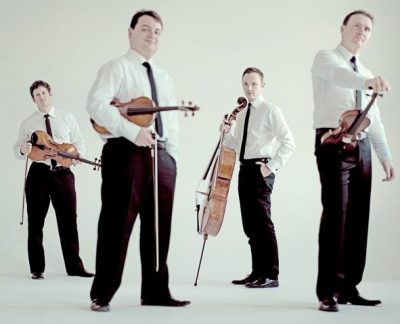Jerusalem Quartet finds a bond across time between Beethoven and Janáček

The Jerusalem Quartet performed Thursday night for Chamber Music Houston.
The Jerusalem Quartet made quite a stylistic leap Thursday in Rice University’s Stude Concert Hall. It opened its Chamber Music Houston program with Beethoven’s Quartet in F minor, Op. 95, the “Quartetto Serioso.” Then, skipping a century of musical evolution, the group launched into Leoš Janáček’s Quartet No. 1, “The Kreutzer Sonata.” And the players revealed musical kinships that bridged the two composers.
Yes, Janáček’s subtitle harks back to Beethoven. But he actually took it from a story by Leo Tolstoy: The Kreutzer Sonata, which refers to Beethoven’s Violin Sonata No. 9. Janáček’s quartet has no connection to the sonata’s mood or music, much less to the “Quartetto Serioso.” The Jerusalem Quartet revealed deeper links between the two quartets. And the ensemble’s vividness, precision and richness made them all the more compelling.
The group evidently needed no time to settle in. The brusque unison theme that opens “Quartetto Serioso” rang out as if the players spoke with a single, robust voice. Yet when more lyrical, individual voicings were called for moments later, the four musicians — violinists Alexander Pavlovsky and Sergei Bresler, violist Ori Kam and cellist Kyril Zlotnikov — relished their independence. As the melody moved from one player to another, each made it reach out yearningly, while his compatriots complemented the line with a murmuring, deftly woven background.
For the rest of the turbulent first movement, the group savored the music’s contrasts. As the terse opening motif took more and more explosive forms, the players made it lash out in taut, fiery phrases. But they never let force deteriorate into coarseness. And when the music’s gentler side reasserted itself, the players brought out its songfulness and intimacy, and its instances of warmth. The group’s flair for eliciting drama and feeling at every turn would make the rest of the work — and later Janáček’s quartet — just as potent.
After the hushed, tense close of the first movement, cellist Zlotnikov opened the second just as quietly. But now an introspectiveness prevailed, and the musicians spun out the music tenderly, and even sweetly, until it was time to summon more full-throated, enunciated tones.
Their reading of the third movement paired a sometimes biting, sometimes brooding intensity with deftly turned melody. Surging ahead in the final movement with a barely contained tension, the players then delivered a burst of brightness and agility to usher the “Quartetto Serioso” to its happy ending.
The parallels emerged as soon as the ensemble commenced with Janáček, His Quartet No. 1 — interpreting Tolsoy’s story of a bitterly unhappy marriage — also gets its power from pithy themes, sudden changes of mood and texture, fierce climaxes, and bursts of heartfelt melody.
Janáček’s music is, if anything, even more concise and volatile. And the musicians threw themselves into it Thursday, wielding an even wider range of tone and color — from hauntingly quiet to ferocious — than they had in Beethoven. Yet they still held onto their polish, focus and assurance.
Each strand of the music came alive: Melodies that were just a few notes long swelled and subsided expressively; and a single instrument’s vigorous outcry could create an arresting contrast with the rest of the group — embodying, perhaps, the domestic turbulence in Tolstoy’s novella. Thanks to Pavlovsky, some of the first violin’s flights of melody had the impact of plaintive soliloquies.
As the intensity built, another electrifying ingredient appeared: the ponticello bowing effects — source of a hollow, metallic tone that can either whisper or scream. Yet the group never let the ponticello lines lapse into mere scraping, as some quartets do.
After intermission, the players slipped adroitly into the buoyant rhythms, sleek lines and subtle shadings of Claude Debussy’s Quartet in G minor. As in Beethoven and Janáček, the players did build up to some bursts of abandon. But they put their emphasis on the supple flow of melodies, crisp energy and the spring in the music’s step. The Andantino, with its long, silky lines and glowing half-shades, was a particular treat: Without turning lethargic, it exuded stillness. And the group brought something of the same aura to its encore, the slow movement of Beethoven’s Quartet in F major, Op. 135.
Chamber Music Houston returns April 12 with Artemis Quartet playing Mozart, Bartok and Schumann. chambermusichouston.org
Posted Mar 23, 2018 at 5:02 pm by John Epstein
Excellent review of a superb performance. Thanks!